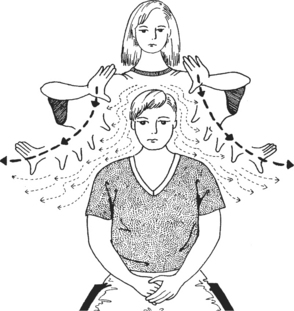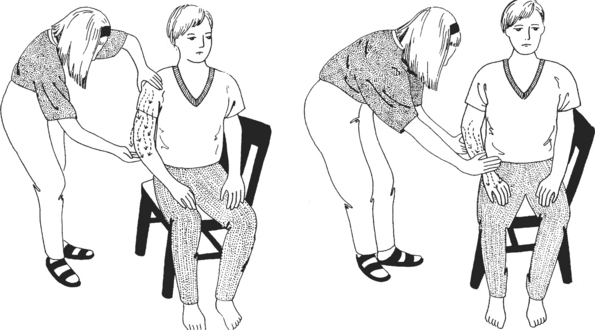Chapter 14 Therapeutic Touch
 Initial Examination
Initial Examination
Client Goal: To decrease pain so that he can continue to coach his son’s soccer team
 Plan of Care
Plan of Care
John attended four physical therapy sessions, which included ice and high-voltage electrical stimulation to the right knee, along with isokinetic exercises of both lower extremities. He also started a group aquatic exercise program at the local pool two times per week. He reported that the combination of physical therapy and the underwater exercise was helping him gain some lower extremity strength and muscular endurance, but he was frustrated that the pain relief he got from therapy did not last. He was instructed to ice his knee whenever he felt pain, but John reported that this was not always possible.
INVESTIGATING THE LITERATURE
Preliminary Reading
Several books written about TT1–4 describe TT as a complementary therapy developed in the 1970s by Delores Krieger, RN, PhD, and Dora Kunz to promote health and healing. Persons with pain, anxiety, and a variety of other conditions are reported to benefit from receiving TT. Four assumptions form the basis for how and why TT is thought to facilitate health and healing. The first assumption as described by Krieger1 is that the body is an open energy system, in which energy flows within and through the body in a dynamic interface with the environment. The second as-sumption suggests that individuals are bilaterally symmetrical so that the right and left sides of the body and the front and back mirror each other, which allows for a balanced flow of energy. The third assumption is that impairment in biological functioning, illness, or disease is associated with an imbalance of energy or an irregularity of energy flow through the body. The fourth assumption suggests that the body can achieve a process of self-healing through manipulation of subtle energy fields and restoration of appropriate energy levels and flow.1
All the assumptions underpinning TT’s ap-proach and process to healing have their roots in the ancient Hindu concepts of prana and chakras.3,5 Prana, equivalent to chi or qi, is considered to be a universal life energy that circulates through the universe and all living things. Chakras are energy centers positioned at strategic, vital areas of the human energy field that are associated with an endocrine gland and major nerve plexus. Chakras are able to receive, transform, and send prana through a vast network of interconnecting channels, known as nadis. A blockage, interruption, or imbalance of energy flow is thought to exist when disease or pathology exists within a bodily system or systems. Restoring or rebalancing an individual’s personal energy field or energy flow is important for the promotion of his or her own inner healing capabilities. Following a stepwise process, a TT practitioner can assess and modulate a client’s energy field with the intention of promoting self-healing.
From this state of centeredness, practitioners begin the assessment phase by placing their hands 2 to 3 inches from the client’s head and moving their hands down the client’s body, making note of the client’s energy field and acknowledging how the energy is perceived. A practitioner, for example, may describe a client’s energy as blocked or sluggish in a particular area.4 Or the energy may be perceived as vibratory, tingly, hot, or cold in some areas and not others. These observations may suggest that the practitioner should return to these areas later in the process (Figure 14-1).
Krieger1 has described the next step in the TT procedure as “unruffling the field.” During this activity, TT practitioners sweep away bound up or congested energy, which allows the final step of the process to begin with a client’s energy field being open and unrestricted (Figure 14-2). During the final stage of the TT process, practitioners can direct and modulate their own energy and/or the client’s energy in a specific manner to improve energy flow and balance. The intention is for the client’s energy flow to be balanced and the energy field to be symmetrical so that healing can occur (Figure 14-3).
During a typical TT session, clients remain fully clothed and are seated in a chair. Sessions usually take approximately 20 to 30 minutes to complete, although practitioners report that some clients may require an hour-long session to achieve a relative state of energy balance. Frail clients and children may benefit from just 5 to 8 minutes of TT.6
Licensed health care providers and consumers should be aware if specific credentials or training are required to ensure the appropriate application of a therapeutic approach or modality. Despite the similarities between TT and the “laying-on-of hands” approach to healing, Krieger and Kunz do not believe that people need to be “chosen” by a higher entity to be a healer. They suggest that everyone is capable of developing a keen awareness of health and dysfunction and that anyone can heighten their perception of subtle energy if they desire to do so.1 Krieger has been successful in integrating the teaching of TT into many nursing school curriculums across the United States and has endorsed the teaching of TT to anyone who is committed to helping others heal. According to Nurse Healers Professional-North America (NHP-NA), an organization that promotes the work and teaching of TT, more than 85,000 people have learned TT worldwide. Basic TT concepts are taught in 12-hour weekend workshops, although practice is required to develop proficiency and skill. NHP-NA recommends those practitioners wanting to practice in a medical or health care environment complete a 1-year mentorship with a qualified TT practitioner or teacher and participate in an intermediate level workshop. Although no standard requirements or certification to be a TT practitioner exist, the Self-Evaluation Tool of Therapeutic Touch Scale (SETTS), developed by Krieger and Patricia Winstead-Fry, PhD, RN, can be used to assist clients in discriminating between experienced and proficient practitioners and those who are less experienced.2
Another way to determine a practitioner’s level of proficiency is to inquire if the TT practitioner is a qualified to-be instructor. To be recognized by NHP-NA as a qualified TT instructor, the practitioner needs to have practiced TT regularly for 5 years, had 1 year of mentorship, completed two advanced workshops, and had 1 year of teaching mentorship with a qualified TT instructor.
Stay updated, free articles. Join our Telegram channel

Full access? Get Clinical Tree


 Evaluation
Evaluation







